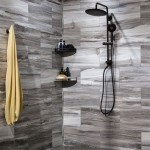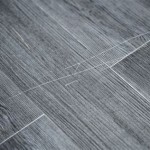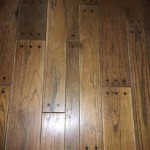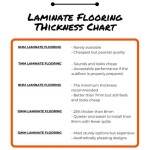Laminate Flooring: Achieving the Tile and Stone Aesthetic
Laminate flooring has emerged as a versatile and cost-effective alternative to traditional flooring materials such as tile and stone. Advances in manufacturing technology have enabled laminate flooring to convincingly replicate the appearance of natural materials, offering homeowners a way to achieve the desired aesthetic without the associated costs and installation complexities.
The popularity of laminate flooring that resembles tile and stone stems from a confluence of factors. These include the desire for durable, easy-to-maintain flooring solutions, the appeal of natural stone and tile designs, and the budgetary constraints faced by many homeowners. Laminate addresses these needs by providing a visually appealing surface that is resistant to scratches, stains, and fading, while also being significantly more affordable and simpler to install than authentic tile or stone.
This article explores the features, benefits, and considerations associated with laminate flooring designed to mimic the look of tile and stone. It will delve into the manufacturing processes that enable realistic replication, the performance characteristics of these products, and the factors to consider when selecting and installing laminate flooring for a tile or stone appearance.
Realistic Replication Through Advanced Manufacturing
The ability of laminate flooring to convincingly imitate tile and stone is primarily due to sophisticated manufacturing techniques. The process begins with a high-density fiberboard (HDF) or medium-density fiberboard (MDF) core, which provides the structural foundation of the flooring plank. This core is then overlaid with a decorative layer, which is a high-resolution photographic image of the desired tile or stone pattern.
The quality of the decorative layer is crucial to achieving a realistic appearance. Manufacturers utilize advanced printing technologies to create highly detailed images that capture the nuances of natural stone and tile, including variations in color, texture, and veining. The printed image is typically treated with a melamine resin, which enhances its durability and resistance to wear. The final layer is a transparent wear layer, composed of aluminum oxide particles embedded in a melamine resin. This wear layer provides a protective barrier against scratches, scuffs, and fading, ensuring the longevity of the flooring's appearance.
Texturing plays a significant role in enhancing the realism of laminate flooring. Embossed-in-register (EIR) technology is often used to create a surface texture that aligns precisely with the printed image. This means that the texture follows the contours of the stone or tile pattern, creating a tactile experience that closely mimics the feel of the real material. For example, if the laminate is designed to resemble slate, the surface will have a rough, uneven texture that corresponds to the slate pattern. Similarly, if the laminate is designed to resemble travertine, the surface will have subtle indentations and pores that mimic the natural stone.
The edge treatment of the laminate planks also contributes to the overall aesthetic. Beveled edges, for instance, can create the illusion of individual tiles or stones, further enhancing the realism of the installation. The edges can also be treated to match the color and texture of the surface, creating a seamless and authentic look. Micro-bevels are often preferred for their subtle definition, while larger bevels can create a more pronounced grout line effect.
Performance Advantages and Practical Considerations
Beyond its aesthetic appeal, laminate flooring offers several performance advantages that make it a practical choice for many homeowners. One of the primary benefits is its durability. The wear layer provides exceptional resistance to scratches, dents, and stains, making laminate flooring suitable for high-traffic areas and homes with pets or children. Unlike natural stone or tile, laminate is also resistant to chipping and cracking, which can occur due to impact or settling of the subfloor.
Maintenance is another key advantage of laminate flooring. It is relatively easy to clean and maintain, requiring only regular sweeping or vacuuming to remove dirt and debris. Spills can be easily wiped up with a damp cloth, and stubborn stains can be removed with a mild detergent. Unlike porous materials such as natural stone, laminate does not require sealing or specialized cleaning products.
Installation of laminate flooring is generally simpler and faster than installing tile or stone. Most laminate flooring products feature a click-lock system, which allows the planks to be easily interlocked without the need for adhesives or grout. This simplifies the installation process and reduces the time and cost associated with professional installation. Homeowners with basic DIY skills can often install laminate flooring themselves, saving on labor costs. However, proper subfloor preparation is essential to ensure a successful and long-lasting installation. The subfloor must be level, clean, and dry before installing laminate flooring.
Laminate flooring is also more comfortable underfoot than traditional tile or stone. The HDF or MDF core provides a degree of cushioning, making it more comfortable to walk on for extended periods. Laminate flooring also tends to be warmer than tile or stone, particularly in colder climates. This can reduce the need for rugs or other floor coverings to provide warmth and comfort.
Cost-effectiveness is a significant factor driving the popularity of laminate flooring. It is generally less expensive than natural stone or tile, both in terms of material costs and installation costs. This makes it an attractive option for homeowners who want to achieve the look of high-end flooring without breaking the bank. Laminate flooring also tends to be more readily available than certain types of natural stone or tile, which can sometimes be difficult to source or require long lead times.
Selecting and Installing Laminate Flooring for a Tile or Stone Appearance
When selecting laminate flooring designed to resemble tile or stone, several factors should be considered to ensure a satisfactory outcome. One of the most important considerations is the quality of the product. Look for laminate flooring with a thick wear layer and a high AC (Abrasion Class) rating. The AC rating indicates the flooring's resistance to abrasion and wear, with higher ratings indicating greater durability. For residential use, an AC3 or AC4 rating is typically sufficient, while commercial applications may require an AC5 rating. The thickness of the laminate planks also contributes to their durability and stability. Thicker planks tend to be more resistant to warping and flexing.
The aesthetic considerations are equally important. Choose a laminate pattern that complements the overall style and décor of the room. Consider the size and shape of the tiles or stones that the laminate is designed to resemble. Larger tiles can create a more spacious and contemporary look, while smaller tiles can create a more traditional and intricate look. Pay attention to the color and texture of the laminate, ensuring that it complements the existing color scheme and architectural features of the room.
Before installing laminate flooring, it is essential to prepare the subfloor properly. Ensure that the subfloor is level, clean, and dry. Any imperfections in the subfloor can telegraph through the laminate flooring, creating an uneven surface and potentially damaging the flooring over time. If the subfloor is uneven, it may be necessary to use a self-leveling compound to create a smooth and level surface. Clean the subfloor thoroughly to remove any dirt, dust, or debris. Allow the laminate flooring to acclimate to the room's temperature and humidity for at least 48 hours before installation. This will help to prevent warping or buckling after installation.
During installation, follow the manufacturer's instructions carefully. Use the appropriate tools and techniques to ensure a proper fit and finish. Leave an expansion gap around the perimeter of the room to allow for expansion and contraction due to changes in temperature and humidity. Use shims to maintain the expansion gap and ensure that the flooring is properly aligned. When cutting laminate planks, use a sharp saw blade to prevent chipping and splintering. Wear safety glasses and gloves to protect yourself from injury.
Once the installation is complete, clean the flooring thoroughly to remove any dust or debris. Use a mild detergent and a damp cloth to clean the surface. Avoid using excessive water, as this can damage the laminate flooring. Regular cleaning and maintenance will help to prolong the life of the flooring and maintain its appearance. Protect the flooring from scratches and dents by using furniture pads under the legs of chairs and tables. Avoid dragging heavy objects across the flooring.
In conclusion, laminate flooring that resembles tile or stone offers a compelling combination of aesthetic appeal, durability, and cost-effectiveness. By understanding the manufacturing processes that enable realistic replication, the performance characteristics of these products, and the factors to consider when selecting and installing laminate flooring, homeowners and designers can create beautiful and functional spaces that mimic the look of natural materials without the associated drawbacks.

Stone Look Laminate Flooring Ll

Types Of Laminate Flooring The Home Depot

Summit 10mm Loch Stone Laminate Tile

Faux Stone Laminate Options

Stone Look Laminate Flooring Ll

Pergo Sample Portfolio Wetprotect Marengo Stone Waterproof Tile Look Laminate Flooring In The Samples Department At Com

Colours Leggiero Stone Effect Laminate Flooring 1 86m² Diy At B Q

Stone Look Laminate Flooring Kitchen Remodel

Laminate Vs Vinyl The Home Depot

Stone Tile Slate Laminate Flooring For Strongsville Brunswick Elyria Medina
Related Posts








